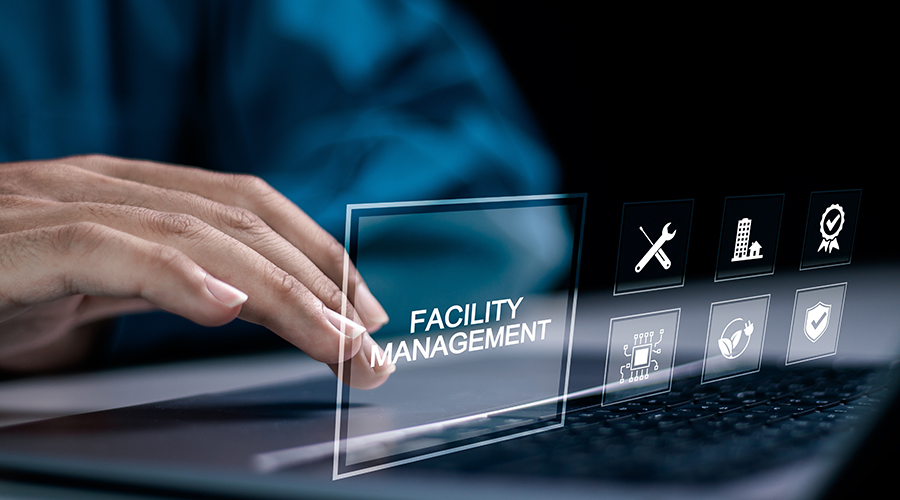Giving Facilities an Information Edge
A steady evolution in facility technology is making it easier to share information. The payoff: better and faster decision making
By Brandon Lorenz, Senior Editor
Plain old remote dispatching is nothing new to many facility executives. For years, staffs have used pagers and cells phones to spend more time working and less time driving. But facility executives who think remote dispatching represents cutting edge information technology are missing out on a range of increasingly powerful tools and strategies that are quietly reshaping the industry.
Though the changes happening today are evolutionary, new technology is bringing steady gains to facility management. Better technology makes facility organizations more intelligent and more nimble, getting the right information to the right person faster than before. The payoff is better and quicker decisions that are implemented sooner. And emerging technology promises to transform the industry much as direct digital controls did when they emerged in the ‘80s.
“Real estate has historically been slow to adopt new technology,” says Diane Herdt, chief information officer for General Services Administration’s (GSA) Public Buildings Service (PBS). “But I’m definitely seeing a change, especially in the Public Buildings Service.”
Consider a property manager who wants to request an air conditioning repair at Opus Corp, a $1.4 billion real estate development company. Instead of placing a call, the manager fills out a form on the company’s Web site.
Thanks to the company’s new system, which has been in place for eight months, engineers in the field automatically receive a notice on their mobile devices of the repair request, says Lorin Ludwig, director of technical services for Opus.
Engineers tied into such systems have a wealth of information at their fingertips. Software loaded with a facility’s mechanical information can tell an engineer what tools are needed to service the equipment. The engineer’s mobile device will track and report how long the repair took to complete. In some cases, the systems will dispatch a follow-up survey to the tenant to ensure the repair was completed satisfactorily.
Similar examples are occurring across the facility landscape. Technology isn’t redefining the way business is done. Rather, new, more robust technology, along with more sophisticated approaches to using technology, are speeding information sharing and decision making.
“We still have a ways to go,” says Herdt. “But we are past the emerging phase.”
Today, technology strategies are likely to develop in three layers, says Eddie Wagoner, chief information officer, Jones Lang LaSalle. The foundation layer contains production systems needed to manage work orders,
invoices, billings, rent rolls and sometimes call centers. Building automation and energy management systems can be included at this level too.
One step up is the dashboard. Rather than having to sort through financial statements for each property in a portfolio for key performance indicators, a dashboard allows facility executives to “manage by exception.” Information is collected and indicators that fall above or below a preset tolerance are automatically highlighted. (See “Benchmarking” in the March 2006 issue of Building Operating Management.)
“You don’t really need technology to build, lease or manage a building,” says Wagoner. “People were doing it for years before computers were on anyone’s desktop. But if you want to be efficient, you need the technology.”
Efficiency is important not only because more information is being generated, but because more users are demanding access to the data. Many corporations have more information reporting requirements in a Sarbanes- Oxley world, increasing the need for data collection, Wagoner says.
The third level is to manage proactively based on the data collected. For example, if the dashboard for a particular metric says that a type of task should be completed in seven days, a facility executive would highlight the times that task took longer and determine whether any business processes could be changed.
“You’re looking at things in aggregate,” says Wagoner. “Operations and maintenance can be millions of dollars. By using things like Six Sigma to get more proactive, even tweaking something will drive value back into the portfolio.”
Solid business practices serve facility organizations well regardless of how sophisticated the approach to technology is. Pairing top-notch business processes with new technology makes for an even stronger impact.
Technology Gains
Technology is improving the facility landscape in ways both familiar and new. At one time, the only way to manage documents was on paper, in files that might not have been located in a central location. A common improvement is to scan leases and other documents into a Web database that can be accessed from virtually anywhere.
Today, some companies are going one step further. Software is available to scan contracts and agreements looking for terms, and when certain dates in the contracts are reached, the software can send out notices to the appropriate employees.
“Say you have vendor contracts,” says David Flynn, executive vice president of global client services for Grubb & Ellis. “You can scan them for budgeting purposes and look at all the contracts coming up on a certain date. Or you can see what the annual cost is of landscaping across the portfolio.”
Meanwhile, as reception improves and technology becomes more sophisticated, mobile technology will become even more common, with workers in the field staying connected via the Internet in more sophisticated ways, experts say.
Consider the following scenario. If a company wants to survey its buildings to ensure they comply with the Americans with Disabilities Act, a worker can use a tablet PC to do the survey, taking notes and photographs that are added into the company’s Web portal. Besides reporting the results nearly instantaneously, using a company Web database on the tablet PC keeps the survey data uniform, unlike a paper survey.
“There are some limitations with PDAs and cellular devices because of signal strength issues,” says George Hickey, director of information technology, client technical services for Grubb & Ellis. “But the industry is moving forward and is starting to accelerate. Mobile technology is going to increase the performance of everything from end-to-end in service delivery.”
If there’s any surprise in the idea that mobile technology will reshape real estate, it’s only that it didn’t happen sooner. “Real estate has historically been behind other industries in the use of technology, and for good reason,” says Wagoner. “There has been a lot of catch up, and I think in the next few years it will catch up even more.”
Technology is Not a Plan
Technology may be getting more sophisticated, but ultimately, even the best real estate technology depends on good business practices to be successful.
“Technology is not a silver bullet,” says Wagoner. “I think a lot of companies are aware of that now. Technology is the enabler. You have to have good people and good processes for managing the business.”
When facility executives combine the right technology with solid business practices and good training, the outcome is better facility and real estate decisions made more quickly than ever.
“The real value is when you have good business processes with good technical execution,” says Flynn. “That’s where you transform information into actionable data.”
Even at a basic level, facility executives shouldn’t assume technology can automatically trim tasks assigned to facility personnel. Such decisions should be made carefully, with consideration given to how occupants could be affected.
“One problem since systems have become more reliable and standardized is that it’s easy to get lulled into a sense of complacency,” says Ludwig. “It’s important to continue to focus on the fundamentals.”
A technician might use remote technology to adjust a damper in a building after an occupant complains that a space is too cold, for example. But if there is no follow-up survey sent, or if the technician doesn’t check the discharge air temperature, any number of things could go wrong, even though the technician thinks the job is complete. The wrong zone could have been adjusted, says Ludwig. Or the damper motor may have stopped functioning.
“I constantly see that an overdependency on technology can cause trouble,” Ludwig says. “Things like that need to be followed up on to make sure the diagnosis is correct.”
The Future is Virtually Here
Unlike some of technology’s more evolutionary changes, building information modeling (BIM) is a major shift that has the potential to bring significant efficiencies to the way buildings are designed and constructed.
BIMs come in varying degrees of sophistication, from massing models that are limited to basic dimensions of a building to floor-by-floor structural models. The most advanced model is a three-dimensional computer representation of the physical and functional characteristics of a building. Such a model would contain, in one accessible database, virtually all the information about a facility, from warranty information about components such as chillers and roofing systems to floor plans and seating charts.
There are multiple advantages to BIM. With information such as blueprints and manuals still recorded on reams of paper, keeping data alive in a BIM would reduce the time facility executives need to search for information. The International Alliance for Interoperability, part of the National Institute of Building Sciences, has estimated that 10 to 30 percent of a facility executive’s time can be spent simply searching for information.
“BIM is still evolving,” says Herdt. “It’s not mainstream yet, but it’s definitely where we are going.”
A BIM could reduce construction delays by spotting design conflicts earlier in the process, reducing the need for change orders. It could also potentially speed code compliance checks. Compliance checks could someday be made nearly automatic by submitting a BIM electronically to a code authority.
PBS began working with BIM in 2003 with 10 pilot projects, says David Winstead, PBS commissioner. Today, any PBS construction project that exceeds $2.5 million is required to use BIM, he says.
“We’ve had huge issues over the last three or four years with material cost increases in our markets,” says Winstead. “BIM helps coordinate the design program and construction phases.”
Make Sure Data Makes the Cut
Ensuring the quality of data becomes critical as the industry moves toward BIMs, which could house data on a building for decades after construction.
And when facility executives are looking at their dashboards, if they aren’t making apples-to-apples comparisons, they could unknowingly reach faulty conclusions. Consider the implications if a property manager in one building measures square footage according to the standard from Building Owners and Managers Association (BOMA) and another property manager uses the International Facility Management Association (IFMA) standard. BOMA takes into account common areas when measuring floor space, for example, while IFMA does not.
If the information isn’t compiled into a system that highlights when different standards are used, the potential is high for faulty decision making.
The need for reliable data has become more critical as real estate technology has matured and as real estate companies churn their portfolios more rapidly. REIT activity and the accelerated pace of mergers and acquisitions in recent years means portfolios are changing faster than before.
The Open Standards Consortium for Real Estate (OSCRE) is leading the charge to standardize real estate terminology across the industry. “We’re really trying to get the industry to communicate using the same language,” says Andy Fuhrman, CEO of the group.
“Think about all the information about a property,” says Fuhrman. “The buildings, the suites, a tenant’s contact information, reoccurring charges and lease information. All those things are components that companies need to be able to acquire and quickly get into their own database system.”
Focus on the Business Process
For now, fixing the problem of data interoperability means paying attention to business practice as much as it does the capabilities of the technology being used.
For example, when GSA’s Public Buildings Service wanted to roll out a single system for property management, inventory and billing for its 8,600 buildings, it started by looking first at the processes involved, not the technology, says Herdt.
In the past, leasing for the 342 million square feet of space managed by PBS was handled differently in each of the 11 PBS regions. The first step in building a national system was to look for common terminology and procedures used across the regions.
“Even though there are IT people involved, we really look at it strictly from a business perspective the first couple of go-rounds,” Herdt says.
From big improvements such as BIM to smaller changes such as more robust mobile technology, new information technology has the potential to speed decision making.
“Most of the advances in the last 10 to 20 years are mostly refinements,” says Ludwig. “We still take air into a building and we temper, distribute and exhaust it. The equipment is better, but fundamentally, we’re not doing things differently. We’re doing it more efficiently.”
DATA STANDARDS
Know What You’re Measuring
It’s not uncommon for large companies with properties in multiple states to struggle with keeping their facility data standardized, especially as properties come and go. While national data standards haven’t completely evolved yet to ease the process, companies aren’t letting that stand in the way of using the data they have.
For Eddie Wagoner, chief information officer, Jones Lang LaSalle, that means taking a pragmatic approach to new properties entering the portfolio. “We wish everything could be perfect but it’s not going to be in the foreseeable future,” he says. “We have to do what we can in the here and now.”
Wagoner compares facility data to an encyclopedia. Facility executives can wait for the authoritative Encyclopedia Britannica, which is published annually, to make decisions. Or they could use Wikipedia, an online encyclopedia. Hosted free online, the English version has more than 1.6 million articles that are continuously revised by contributors.
When a new property is purchased, the company could hand data over to the IT department to make sure the data is “clean” before allowing it to be entered into the system, a process that could take considerable time. Instead, the information is quickly added to the company’s relevant dashboards, Wagoner says.
“When a client takes over a portfolio,” he says, “I have no clue what data we are getting from their computers. Some of it might be wrong and some of it will need to be normalized. But they can get access to the good, the bad and the ugly. And if they know what it is, they can start using it earlier.”
It’s an approach that obviously needs to be applied selectively. But with less critical types of data, it can help speed the decision making process after an acquisition, Wagoner says.
One key to making it work is to label dashboards and data that are new or are in the process of being normalized. That helps enable collaboration by getting stakeholders to look at the data for problems, and helps them understand the quality of the data they are looking at when making decisions.
“The problem with Wikipedia is that people read it and think it’s gospel. It’s not,” says Wagoner. “People have put it out there and are looking for others to clean it up.”
|
Related Topics:











